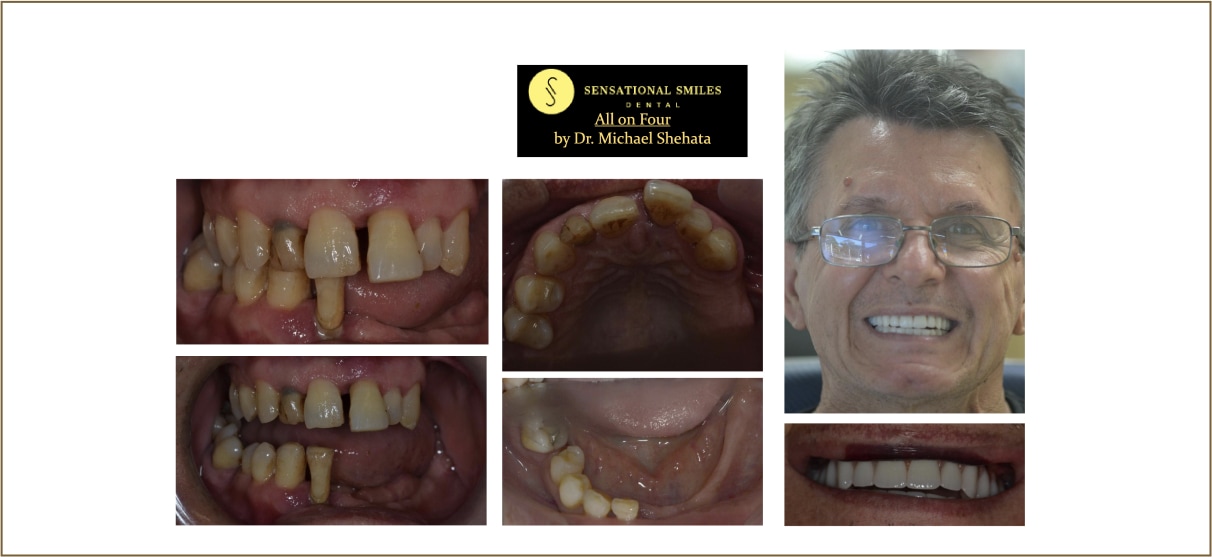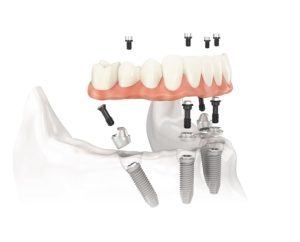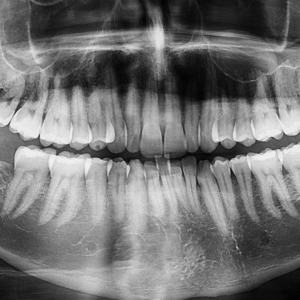
19 Apr Do You Need to Remove Existing Teeth Before All on 4 Implants?
In the world of All On 4 dental implants, the extraction of old teeth rests entirely on their condition. Teeth that are unhealthy or cannot be saved will be removed during the implant surgery. Sometimes, though, some teeth are found fit enough to support the new dental fixtures, eliminating the need for extraction. Hence, each mouth tells its own story and needs unique care.
All On 4 Implant Process
The profound impact of All On 4 dental implants on individuals who have lost multiple teeth is truly remarkable. This cutting-edge implant technique secures a full arch of prosthetic teeth onto just four dental implants, providing unparalleled stability for a permanent solution. Before we delve into the steps involved in the dental implant procedure, it’s crucial to highlight the initial phase of this transformative process, which begins with a comprehensive dental implant examination. During this phase, a diligent assessment is conducted to determine the patient’s suitability for the treatment. This evaluation includes assessing bone health, gum condition, and oral health, ensuring that the patient is an ideal candidate for the procedure. The innovative nature of the All On 4 process lies in its capability to cater to diverse cases, from patients with significant tooth loss to those looking for an alternative to traditional dentures, offering a more secure and comfortable solution.
Following the thorough dental assessment, the next step involves the surgical placement of the dental implants. This is a critical phase where precision and expertise are paramount. The four implants are positioned strategically in jawbone regions with optimal density. These implants are anchors for attaching the custom-made dental bridge, replacing the entire set of missing teeth. The precise placement of these implants is essential for achieving maximum stability and ensuring the long-term success of the prosthetic teeth. Imagine these dental implants as robust pillars supporting a bridge—a foundation that provides unwavering support for the prosthetic teeth. This approach minimises bone loss and offers structural reinforcement to restore the aesthetics and functionality of one’s smile.
Once the dental implants are securely in place, a custom-made dental bridge is expertly attached to them. Crafted with meticulous attention to detail, this bridge is specifically designed to fit seamlessly over your natural gum line and offer a lifelike appearance. Carefully colour-matched and tailored to harmonise with your natural teeth (if present), this custom bridge ensures seamless integration with your existing dentition. At this stage, patients can experience immediate improvement in their ability to eat, speak, and smile confidently, a testament to the life-changing impact of this advanced treatment approach. The All On 4 implant process offers a solution that underscores its commitment to restorative dentistry and its profound impact on enhancing patients’ quality of life through comprehensive oral rehabilitation.
Understanding Old Teeth Extraction
When considering All On 4 dental implants, the question of whether or not to remove existing teeth can be confusing. In many cases, any remaining unhealthy or unsalvageable teeth within the arch receiving the implants may be removed during the implant surgery. Why? Because these teeth may not be strong enough to support the new prosthetics and might even cause further issues once the implants are placed. Imagine this—your natural teeth are like foundational pillars of your oral structure. If they are weak or compromised in any way, it can significantly impact the success and longevity of the dental implants. Unhealthy teeth could lead to complications or discomfort when placed alongside the new artificial teeth. Therefore, to ensure that the All On 4 treatment provides its full benefits, it might be necessary to address any existing dental issues beforehand. However, that doesn’t mean all your teeth must go. A dentist will carefully evaluate each tooth’s condition and overall oral health to determine if extraction is indeed necessary.
For instance, a severely decayed tooth or one with extensive damage may need to be extracted before implantation. On the other hand, if a neighbouring tooth is healthy and strong, it might be deemed suitable for supporting the new dental prosthetics without requiring extraction.
- Dental implant professionals will consider several factors in this decision-making process, including tooth strength, gum health, and overall jaw stability.
- They will also assess the health of the surrounding bone, as dental implants rely on strong bone to provide a sturdy foundation.
The necessity of removing old teeth prior to getting All-on-4 dental implants varies from person to person and is highly individualised. A comprehensive evaluation by your dentist will help determine what’s best for your specific oral health needs.
Expert Insights on All On 4 Implants
When it comes to All On 4 implants, dental professionals often emphasise that individualised assessments are crucial. Every patient is unique, and their oral health conditions vary. Expert insights highlight the need for patients to consult with an experienced dentist in implantology to determine the best course of action. It’s important to remember that not all patients are the same, and neither should their treatment plans be uniform—one size doesn’t fit all. Understanding this reinforces the necessity for a comprehensive assessment by professionals experienced in implant dentistry. It’s not just about taking teeth out and putting new ones in. The procedure involves strategic planning and customisation to ensure long-term success. This underscores the importance of working closely with a skilled practitioner who can tailor treatment plans to meet individual needs.
With all these considerations in mind, let’s explore some specifics about how All On 4 implants work and what types of patients may benefit most from this revolutionary dental solution.
Impact of Pre-Existing Periodontal Disease
Periodontal disease can significantly affect the success of All On 4 implants. When gums are infected, weak or deteriorating, and teeth are severely damaged, it can interfere with the ability to support the new implants properly. Once the assessment for All On 4 implants begins, it’s crucial to evaluate the condition of the existing teeth and surrounding gum tissues. During this evaluation, the dentist will carefully examine the extent of periodontal disease. The health of your natural teeth and their ability to integrate with the new implants is of paramount importance. If it’s determined that the existing teeth have been compromised by periodontal disease and cannot provide adequate support for the implants, extraction may be recommended.
For example, if a patient has advanced periodontitis and there is extensive bone loss around their natural teeth, supporting these teeth can become increasingly challenging. In such cases, removing these affected teeth provides a clean slate for the successful placement of All On 4 dental implants. The primary objective here is not only to create a solid foundation for the new prosthetics but also to prevent any further spread of infection that might affect the longevity and stability of treatment.
Long-Term Success
By addressing pre-existing periodontal disease through extractions when necessary, patients increase the likelihood of long-term success with their All On 4 implants. It ensures that no remaining sources of infection or weakened teeth and gums could compromise the integrity of the new implant-supported dentures. Additionally, resolving underlying periodontal issues before implant placement sets the stage for healthier gums and better oral health. This affects the success of the implant treatment and contributes to a patient’s general well-being.
Understanding how pre-existing periodontal disease impacts the assessment and treatment process for All On 4 implants highlights the importance of comprehensive dental evaluations and tailored treatment plans to ensure optimal outcomes.
Do All On 4 Implants Replace All Teeth?
The All On 4 treatment is designed to provide a comprehensive solution for those who need extensive tooth replacement. It typically aims to replace an entire upper or lower set of teeth by employing four strategically placed implants, offering newfound stability and functionality to patients who have lost most or all of their teeth.
 This innovative method offers an effective alternative to traditional dentures or individual dental implants. Unlike removable dentures, All On 4 implants are fixed in place and can only be removed by a dentist, which grants individuals peace of mind and confidence in their smiles. The “All On 4” concept focuses on using just four dental implants to support an entire arch of teeth. The strategic placement and angulation of these specially designed implants maximise the use of available bone while avoiding vital structures in the mouth, reducing the need for bone grafting in many cases. This approach allows for immediate function in a vast majority of clinical scenarios.
This innovative method offers an effective alternative to traditional dentures or individual dental implants. Unlike removable dentures, All On 4 implants are fixed in place and can only be removed by a dentist, which grants individuals peace of mind and confidence in their smiles. The “All On 4” concept focuses on using just four dental implants to support an entire arch of teeth. The strategic placement and angulation of these specially designed implants maximise the use of available bone while avoiding vital structures in the mouth, reducing the need for bone grafting in many cases. This approach allows for immediate function in a vast majority of clinical scenarios.
Some might wonder whether “four” implants can adequately replace an entire arch of teeth. However, the number “four” refers to the minimum number of implants required for stability and durability. This approach utilises fewer implants, streamlining the process and reducing cost without compromising reliability or effectiveness. A sturdy table doesn’t need a dozen legs to stand strong – it stands firmly with four well-placed legs. Similarly, these purposefully located implants provide substantial support for a full set of replacement teeth, proving to be a successful method with numerous benefits, such as decreased costs, reduced healing time, and exceptional results.
Furthermore, the All-On-4 concept allows for the immediate fitting of temporary prostheses on the same day as implant placement, providing patients with a complete set of teeth on the same day – a significant advantage that traditional methods cannot offer. Understanding how these implants function and their benefits makes it clear why All-On-4 implants are a sought-after treatment for individuals needing extensive tooth replacement.
Significance of Dental X-Rays in Diagnosis
Dental X-rays, also known as radiographs, are vital tools for dentists. They are invaluable for understanding your oral landscape and making informed decisions about your treatment plan, especially during the All On 4 implant process.

These images serve as a real treasure map for the dentist, providing a detailed view of what’s happening inside your mouth. They help evaluate the condition of your existing teeth, gums, and bone density, allowing the dentist to check for any signs of decay, infection, or structural abnormalities that might interfere with the successful placement of the implants. It’s like having a bird’ s-eye view of your oral health!
The dentist can analyse the position of your dental roots and bone structure, ensuring enough healthy bone to support the implants. This information is essential for determining whether any teeth need to be removed before proceeding with the All On 4 implant placement. Understanding the integrity and strength of your jawbone is crucial in avoiding potential complications. Dental X-rays give insight into how much bone is available and where its density may be compromised.
For instance, if there is severe bone loss due to tooth loss or other issues, additional procedures may be required to build up bone density and ensure a secure foundation for the implants. Without this valuable information from X-rays, it would be challenging for dentists to accurately plan and execute successful implant procedures.
Evaluating Suitability for All-On-Four Implants
The decision to recommend and perform an All-On-4 implant procedure is a comprehensive process that involves careful evaluation by dental professionals. This evaluation covers multiple aspects of a patient’s dental and medical history to ensure that the treatment is suitable and beneficial for the individual.
Assessing Oral Health: One of the first steps in determining candidacy for All-On-4 implants is ensuring that the patient’s oral health is optimal. This includes assessing gum disease, decayed teeth, and the overall condition of the mouth. Any oral health issues must be addressed before proceeding with the implant procedure to avoid complications or infections post-surgery.
Bone Density Evaluation (Diagnostic Imaging): Your dentist will likely conduct a CT scan or another diagnostic imaging to evaluate your bone density in the jaw. This step is crucial because sufficient bone density is essential for properly supporting the implants. If there are concerns about bone density, additional procedures may be needed to prepare the jawbone for implant placement. For example, some patients may need bone grafting procedures to increase bone volume in areas where it has naturally decreased over time, creating a more stable foundation for the implants.
The Role of Existing Teeth
It’s also vital to assess the condition of any remaining natural teeth before deciding on All-On-4 implants. Are these teeth healthy enough to be preserved? Extractions may be recommended so that all necessary treatments can be completed simultaneously without further delays or disruptions to your routine. It’s important for patients undergoing an All On 4 evaluation to openly communicate their medical history with their dental professionals. This includes details about chronic medical conditions, medications, and any previous surgeries. All this information contributes significantly to assessing one’s suitability for the procedure and planning appropriate post-operative care.
In essence, evaluating a patient’s suitability for All On 4 implants involves meticulously assessing various factors such as oral health, bone density, existing teeth condition, and overall medical history. This ensures personalised and effective dental care tailored to each patient’s needs and circumstances.
Are you considering an All-On-4 implant procedure? Contact Sensational Smiles Dental today on (02) 8544 8607 to book a free consultation and take the first step towards regaining your smile.


